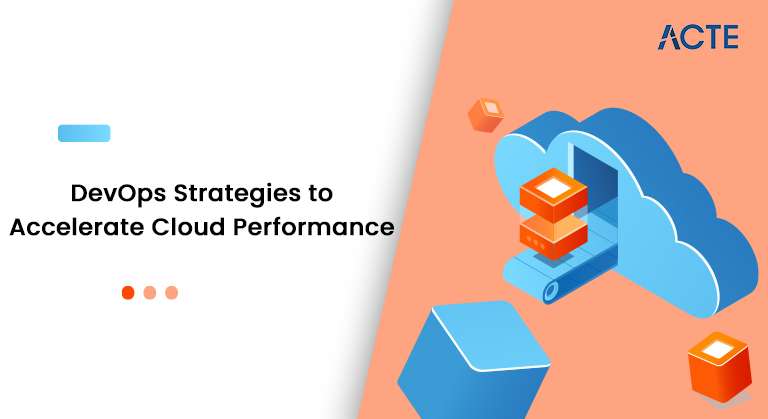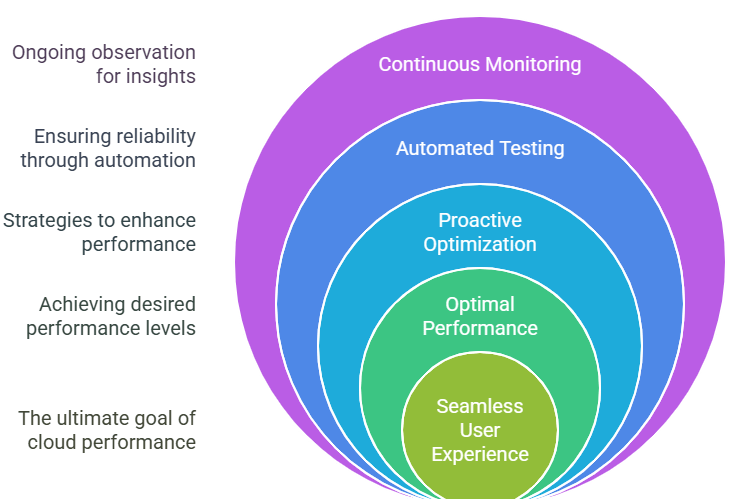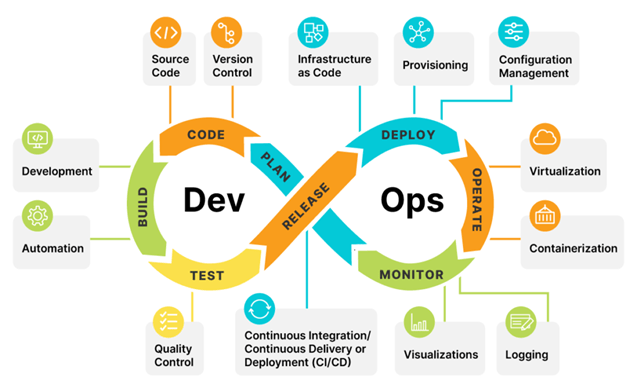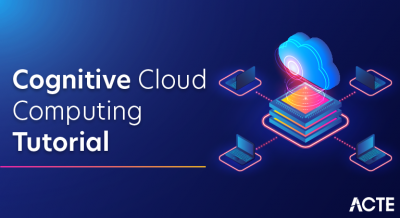
- Introduction to Cloud Performance in DevOps
- How DevOps Improves Cloud Scalability
- Automating Cloud Deployments with DevOps
- CI/CD Pipelines for Cloud-Native Applications
- Infrastructure as Code for Cloud Optimization
- Monitoring and Logging in Cloud DevOps
- Security Best Practices in Cloud DevOps
- Cloud Cost Optimization with DevOps
- Role of AI in Cloud Performance Optimization
- Case Studies:DevOps Success in Cloud Performance
- Overcoming Cloud Performance Bottlenecks
- Future of DevOps in Cloud Computing
- Conclusion
Introduction to Cloud Performance in DevOps
In today’s fast-paced, data-driven world, delivering software applications efficiently and at scale is crucial for businesses to stay competitive. Enrolling in cloud-computing Training Courses can help professionals understand how cloud computing and DevOps practices have emerged as key solutions for achieving this goal. Cloud computing provides the flexibility and scalability needed for modern software applications, while DevOps enables the automation and collaboration necessary to streamline development and operations processes. The combination of cloud computing and DevOps practices offers significant advantages for improving cloud performance, enabling organizations to respond faster to market demands, scale applications effortlessly, and enhance overall system reliability. This article explores how DevOps can enhance cloud performance by focusing on scalability, automation, cost optimization, security, and more.

How DevOps Improves Cloud Scalability
Cloud scalability is a key reason why many businesses turn to cloud computing. It enables organizations to adjust their infrastructure dynamically scaling up or down based on demand ensuring efficient resource utilization and cost-effectiveness. DevOps significantly enhances cloud scalability by automating workflows and streamlining development processes. With the integration of continuous integration (CI) and continuous deployment (CD) in the DevOps lifecycle, teams can roll out changes more rapidly, which supports scalable cloud applications. To better understand the tools that power these capabilities, explore the 20 Best DevOps Tools to Master in Your Career. This automation allows applications to scale automatically in response to traffic fluctuations and shifting resource needs. Moreover, DevOps promotes containerization, where applications and their dependencies are bundled together for seamless deployment and scaling across cloud platforms. Tools like Docker and Kubernetes are frequently used in cloud-native architectures to manage scalability with minimal manual intervention.
Interested in Obtaining Your Wireless Antenna Certificate? View The cloud computing Online Training Offered By ACTE Right Now!
Automating Cloud Deployments with DevOps
- Automation is one of the cornerstones of DevOps, and it plays a crucial role in improving cloud performance. Automated deployments are essential for ensuring that software can be rapidly and reliably deployed to the cloud. With traditional deployment methods, manual configurations and processes often introduce delays, errors, and inefficiencies, especially when scaling applications.
- In a DevOps environment, CI/CD pipelines automate the process of building, testing, and deploying code, ensuring that software can be updated or released more frequently without compromising quality or performance. This automation significantly reduces human error, enhances consistency, and accelerates the release cycle, leading to a more agile and efficient cloud environment.
- Additionally, tools like Terraform and Ansible allow for automating the setup and configuration of cloud infrastructure, making it easier to deploy applications across different cloud platforms with minimal manual intervention.
CI/CD Pipelines for Cloud-Native Applications
Cloud-native applications are built to operate in cloud environments, taking full advantage of features like dynamic scaling, elasticity, and microservices architecture. A key factor in the success of these applications is the implementation of CI/CD pipelines, which streamline the processes of testing, integration, and deployment. These automated pipelines play a vital role in maintaining the performance and reliability of cloud-native systems. A CI pipeline ensures that developers regularly merge code changes into a shared repository, while a CD pipeline handles the automated deployment of that code to staging or production environments. This approach enables continuous delivery, minimizing the gap between development and release, and enhancing the scalability and flexibility of applications in the cloud. Tools such as Jenkins, GitLab CI, AWS Code Pipeline, and Circle CI are commonly used to set up and manage these pipelines efficiently. If you’re looking to gain practical experience with these tools and workflows, enrolling in a DevOps Training can be a valuable step. Such a course offers hands-on training in setting up CI/CD pipelines and equips you with the skills needed to manage cloud-native deployments effectively, ensuring high performance and availability.
Infrastructure as Code for Cloud Optimization
Frequency Range
Infrastructure as Code (IaC) is a practice that allows for the automated provisioning and management of cloud infrastructure using code. In DevOps, IaC enables teams to define their cloud infrastructure in configuration files, which can then be version-controlled and deployed automatically. By using IaC tools like Terraform, AWS CloudFormation, and Pulumi, organizations can achieve better cloud optimization by making infrastructure predictable, repeatable, and scalable. IaC ensures that infrastructure changes can be tracked and reverted if necessary, eliminating the need for manual configuration, which is prone to errors. IaC also allows teams to replicate cloud environments quickly, ensuring consistency across multiple stages of development, testing, and production. As a result, DevOps teams can efficiently optimize their cloud infrastructure, resulting in faster deployments, improved performance, and cost savings
Monitoring and Logging in Cloud DevOps
Effective monitoring and logging are essential for maintaining high performance in cloud environments. DevOps teams must continuously monitor cloud-based applications to ensure optimal performance, detect issues early, and maintain high availability. Cloud platforms such as AWS, Azure, and Google Cloud provide integrated monitoring and logging services like CloudWatch (AWS) and Azure Monitor, offering visibility into application performance and resource usage. To gain a deeper understanding of the skills and qualifications required in this field, you can explore the cloud-computing-article. These insights can help you align your learning path with current industry demands. DevOps teams utilize these tools to track key metrics such as CPU utilization, memory usage, response times, and error rates allowing them to identify and resolve performance bottlenecks in real time. Logging is equally critical for diagnosing the root causes of performance issues. Tools like the ELK Stack (Elasticsearch, Logstash, and Kibana) and Splunk are commonly used to collect logs from various services and generate actionable insights into the health of cloud applications. By leveraging robust monitoring and logging strategies within a DevOps environment, teams can proactively mitigate performance issues before they escalate, ensuring a smooth and reliable cloud experience for users.

Security Best Practices in Cloud DevOps
Security is a critical concern in cloud environments. As organizations scale their applications and deploy them to the cloud, they must ensure that their cloud infrastructure and applications are secure. DevOps practices, particularly the integration of DevSecOps, focus on embedding security practices throughout the entire software development lifecycle. Incorporating security testing into the CI/CD pipeline ensures that security vulnerabilities are detected early in the development process. Tools like Snyk, OWASP ZAP, and SonarQube can be integrated into CI/CD pipelines to automatically scan for vulnerabilities in code, dependencies, and configurations. Additionally, identity and access management (IAM) in cloud platforms is essential for securing cloud resources. DevOps teams can implement role-based access control (RBAC) and use security automation tools to enforce best practices, such as limiting the scope of user privileges and monitoring unauthorized access attempts.
Cloud Cost Optimization with DevOps
As cloud environments are scalable, they can also lead to increased costs if not managed effectively. Cloud cost optimization is an essential aspect of cloud performance management, and DevOps can help organizations optimize their cloud usage and reduce unnecessary spending. DevOps teams can leverage automation and monitoring tools to track and manage resource usage. For example, automatic scaling features in cloud platforms allow organizations to scale their applications up or down based on traffic, preventing overprovisioning and reducing costs. Tools like AWS Cost Explorer, Azure Cost Management, and Google Cloud’s Billing Reports help DevOps teams track costs, identify inefficiencies, and optimize usage by rightsizing resources and utilizing reserved instances or spot instances for cost-effective computing power. By integrating cost management practices into the DevOps workflow, businesses can better control cloud spending without compromising performance.
Go Through These DevOps Interview Questions and Answers to Excel in Your Upcoming Interview.
Role of AI in Cloud Performance Optimization
Artificial intelligence (AI) and machine learning (ML) are playing an increasingly vital role in optimizing cloud performance. These AI-powered tools can forecast resource demand, identify performance anomalies, and even automate performance tuning. In cloud environments, AI enhances scalability, reliability, and resource efficiency. For example, it can predict traffic patterns and automatically scale resources ahead of demand spikes. To effectively leverage these advancements, professionals often seek specialized learning paths like DevOps Training, which helps build the skills needed to implement AI-driven solutions in cloud infrastructure. Moreover, AI-driven monitoring tools analyze performance data and suggest actions to improve application performance. Many cloud providers, including AWS, Azure, and Google Cloud, are embedding AI and ML capabilities into their platforms. Services like Amazon SageMaker and AWS Lambda enable DevOps teams to harness these technologies for cloud optimization, streamlining processes and minimizing manual tasks.
Case Studies: DevOps Success in Cloud Performance
Several companies have successfully implemented DevOps practices to optimize their cloud performance and achieve better scalability and cost efficiency.
- Netflix: Netflix’s adoption of AWS and DevOps practices has allowed the company to scale rapidly and handle millions of concurrent users. By utilizing AWS Lambda for serverless computing and AWS Auto Scaling to dynamically adjust resources, Netflix delivers seamless streaming services to users around the globe, ensuring optimal performance during traffic spikes.
- Airbnb: Airbnb uses DevOps and AWS to maintain high availability and improve scalability. With the help of Terraform for infrastructure as code and CI/CD pipelines, Airbnb can quickly deploy new features and scale their infrastructure to accommodate growing user demand without performance degradation.
Overcoming Cloud Performance Bottlenecks
Cloud performance bottlenecks can occur due to a variety of factors, including inefficient resource management, suboptimal cloud configurations, and network latency. DevOps practices, such as continuous monitoring, logging, and automated scaling, help identify and resolve bottlenecks quickly. By leveraging tools like load balancers, auto-scaling, and distributed caching, DevOps teams can prevent or mitigate bottlenecks in cloud performance, ensuring that applications maintain consistent performance under varying loads.
Future of DevOps in Cloud Computing
DevOps engineering is shaping the future of cloud computing by driving efficiency, speed, and scalability. As businesses adopt technologies like AI, edge, and serverless computing, DevOps engineering becomes essential in streamlining deployment and performance. The focus is shifting toward automation, real-time monitoring, and predictive analytics empowering teams to stay agile and competitive in a rapidly evolving digital world.
Conclusion:
By adopting DevOps practices in the cloud, organizations can achieve improved scalability, faster deployment, enhanced security, and reduced costs. These practices streamline development and operations, enabling teams to collaborate more effectively and respond quickly to changing business needs. The integration of AI and automation will continue to revolutionize cloud performance, optimizing resource utilization and minimizing human error. This evolution empowers businesses to deliver high-quality applications with greater speed, reliability, and efficiency, maintaining a competitive edge in the digital landscape.



